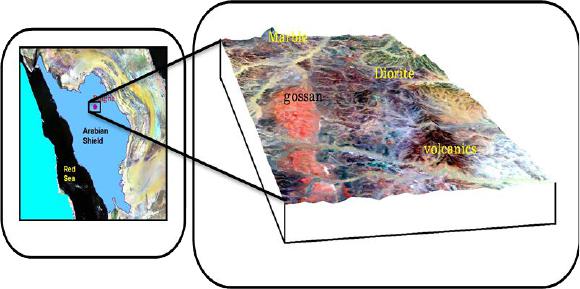
A. MADANI
Figure 1. 3D per specti ve view of Lan dsat false color composite (FCC) image (bands 7, 4 & 2; RGB) draped over Shuttle
Radar Topography Mission (SR TM ) dig it al el ev ati o n mode l sh ow s th e dif fe re nt ro ck u nit s ex po se d at t he st udy are a.
diorite intrusions. The study area hosts mainly syn- to
late tectonic gold-bearing diorite intrusions. Gold depo-
sits at Bulghah area are considered to be mesothermal
gold deposits, a major type of gold mineralization in the
Arabian Shield, and particularly abundant in the western
part of the Afif terrane [4].
Reference [5] studied in detail the spectral characte-
ristics of the mineralized diorite intrusions exposed at
Bulghah mine area, Saudi Arabia, using FieldSpec spec-
troradiometer and Landsat ETM+ data. They categorized
the diorite intrusio ns at the study area into (group A; lo w
general reflectance values) and (group B; high reflec-
tance values with three main absorption features around
1.45 μm, 2.20 μm and 2.35 μm wavelength regions).
Band ratio and image fusion are the most important
techniques used for lithologic discrimination and geo-
logical mapping. Band ratio can be simply generated by
dividing the reflectance value of each pixel in one band
by the reflectance value of the same pixel in another
band [6]. Image fusion technique is a process of combin-
ing multi-spectral and panchromatic images to produce a
new scene which has the best of original images. Image
fusion algorithms can be categorized into low (pix-
el-level), mid (feature-level) and high (symbolic) level.
Many algorithms are developed to fuse high spectral res-
olution image with the high spatial resolution panchro-
matic image such as brovey, IHS (Intensity-Hue-Sat ura-
tion), P CA (Principal-Co mpo ne nt -Analyses), HSV (Hue-
Saturation-Value) and Wavelet transform. Merging infor-
mation from different imaging sensors involves two dis-
tinct steps [7]. First, the digital images from different
senso rs a re ge ometrically registered to one another. Next,
the information content spatial and spectral is mixed to
generate a single image that contains the best of both sets.
The merging of the three multispectral band s with another
image channel is ca rried out by inte nsity substitutio n [8].
The present study aims to: 1) understand the spectral
characteristics of diorite, gossan, marble and volcanics,
the main rock units exposed at the study area, using
FieldSpec measurements and apply the acquired know-
ledge for rock discrimination using band ratio tech-
nique; 2) assess the accuracy of brovey and HSV image
fusion techniques for mapping purposes visually and
statistically.
2. Materials and Methods
Table 1; shows the technical characteristics of Landsat
ETM+ and SPOT-5 data used throughout this study.
Landsat ETM+ scene has eight broad spectral bands. Six
of these bands detect visible, Near Infrared (NIR) and
Short Wave Infrared (SWIR) radiations (0.45 μm to 2.35
μm) with 30 meters spatial resolution. Band seven de-
tects thermal radiation with 60 meters spatial resolution
whereas band eight has 15 meters spatial resolution. The
six non-thermal landsat bands are used to generate band
ratio images. SPOT 5 was launched on May 4, 2002 and
has two high resolution geometrical (HRG) instruments.
SPOT-5 records data in two different modes, low-reso-
lution multispectral mode (10 m and 20 m) and high-
resolution panchromatic mode (2.5 to 5 m). High spatial
resolution SPOT-5 panchromatic band (5 m) is used in
the pre se nt study for mergi ng pr o ce ss.
2.1. Spectral Characteristics of Ro c ks
Throughout the present study, FieldSpec spectroradi-
ometer instrument is used to collect the spectral data for
diorite, marble, gossan and volcanic rock samples. The
FieldSpec instrument is specifically designed for field
enviro nment to acquire vi sible near-infrared (VNIR) and
shortwave infrared (SWIR) spectra [9]. In the present
study, the spectral data collection took place under suita-
ble weather conditions (sunny, cloud-free day). Data
measurements should be resampled as “RTRTRTRT”
format in which “R” refers to reference spectra on a
white panel whereas “T” refers to the measured rock
sample. Figure 2 shows the compiled FieldSpec profiles
for diorite, marble, gossan and volcanics. Three main
OPEN ACCESS IJG